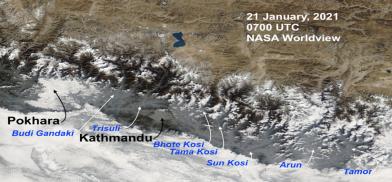How transboundary haze affects Nepal
The Himalayan mountains act as a barrier separating the clean air of the Tibetan Plateau from the polluted Indo-Gangetic plains

The Himalayan mountains act as a barrier separating the clean air of the Tibetan Plateau from the polluted Indo-Gangetic plains. But Nepal’s rivers cut through the mountains, and their valleys allow smog from the plains to penetrate deep into the mountains.
This haze intrusion goes up to elevations of 4,000m, and the pollution layer is more shallow and flat in winter, and inclined and parallel to the ridgeline in the pre-monsoon. The depth of this pollution layer up the valleys also decreases with elevation.
These visible air pollution images are captured regularly by the MODIS (Moderate Resolution Imaging Spectroradiometer) instrument aboard the two NASA satellites Terra and Aqua orbiting the Earth. The dull bluish haze is mostly made up of fine aerosol particles and extends right across the Indo-Gangetic plains from Pakistan to Bangladesh, as well as the Tarai in Nepal.
https://www.nepalitimes.com/here-now/how-transboundary-haze-affects-nepal/








Post a Comment